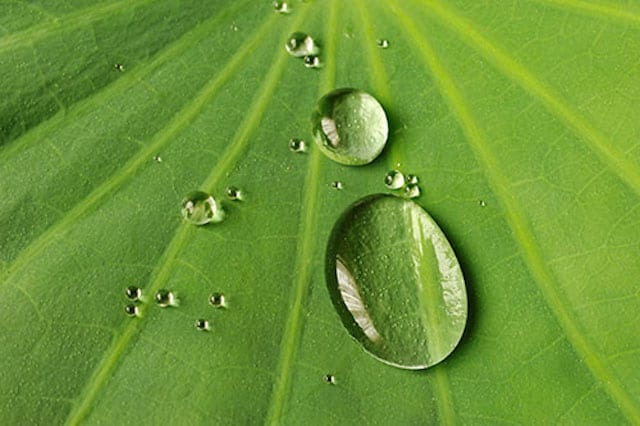The lotus leaf is one of the most water-repellent surfaces on Earth. Now a low-cost class of materials that mimic its properties could be used as a water-repellent coating, reducing the use of hazardous chemicals.
The new class of superhydrophobic nanomaterials, developed by researchers in the US and UK, is non-toxic, simple to manufacture, and can be applied to surfaces through spray or spin-coating.

The materials could replace the expensive and hazardous fluorocarbons often used to protect surfaces from water, according to Professor Julian Eastoe at Bristol University, a member of the research team.
“The big problem with fluorocarbon is its persistence, as it is very difficult to get rid of from the body, unlike hydrocarbons,” he said. “Here we have a material that does not contain fluorine, but performs in an identical way.”
The coating, unveiled in the American Chemical Society journal ACS Applied Materials and Interfaces, mimics the microscopic and nanoscopic structure of the lotus leaf surface, which gives the plant its ability to repel water.
A combination of papillae within their epidermis - or outer layer of cells - and a coating known as an epicuticular wax on top, minimise water droplets’ adhesion to the surface.
To mimic this arrangement, the researchers used aluminium oxide nanoparticles to act as the papillae. They then coated these with modified carboxylic acids with highly branched hydrocarbon chains.
These chains are spiky, resulting in a rough surface that traps a layer of air on top. This minimises the contact between the water droplets and the surface, causing the beads of water to simply slide off.
The ability of a material to repel water is measured by its contact angle. This is the angle where the surface of the water meets that of the material, and the greater the beading of the droplet, the higher this angle will be.
To qualify as superhydrophobic, a material must have a contact angle of 150 degrees or above. The new material, known as a branched hydrocarbon low-surface energy material (LSEM), has an angle of 155 degrees, a figure similar to that of the best fluorocarbon coatings.
The team, led by Professor Andrew Barron at Rice University, also included researchers from Swansea University and the University of Nice Sophia Antipolis.
The researchers are now hoping to improve the material’s adhesion to a range of surfaces.




Project to investigate hybrid approach to titanium manufacturing
What is this a hybrid of? Superplastic forming tends to be performed slowly as otherwise the behaviour is the hot creep that typifies hot...